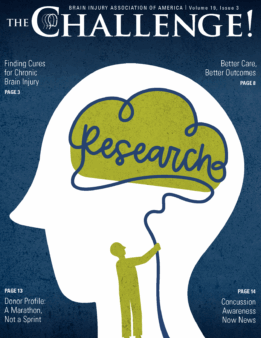THE Challenge! – Research
Categories: THE Challenge!
 The Fall edition of THE Challenge! focuses on brain injury research.
The Fall edition of THE Challenge! focuses on brain injury research.
From My Desk
An estimated 64 million adults in the U.S. have experienced a traumatic brain injury (TBI) and millions more have experienced brain injury as a result of a stroke, tumor, oxygen loss, or overdose. It’s a complicated and dynamic disease process – no two brain injuries are alike, and no two individuals will have the same brain injury journey – making research for treatment and cures equally complicated. Read more.
Finding Cures for Chronic Brain Injury
For many people who sustain a brain injury, they are able to fully recover. They return to the lives they lived before their injury – their relationships, their careers, their hobbies. But many others cannot return to business as usual. They may have to leave the workforce, abandon beloved hobbies, and in some cases, change the trajectory of their lives entirely. Some individuals continue to live with the effects of their injuries – physical, cognitive, psychological, and emotional – for the rest of their lives. But what if they didn’t have to? Read more.
BIAA Publishes 2024 Impact Report
The Brain Injury Association of America (BIAA) has published our 2024 Impact Report. This report documents not only the activities, offerings, and accomplishments that BIAA celebrated in 2024 but also the ways that our organization had an impact on the brain injury community. Read more.
Better Care, Better Outcomes: New TBI Characterization System Aims to Improve Diagnoses and Treatment
The medical community has taken another step toward implementing a new, more robust traumatic brain injury (TBI) characterization system. In May, a coalition of experts from 14 countries proposed a new way to evaluate TBI patients that is expected to lead to more accurate diagnoses and more appropriate treatment plans. The proposed TBI characterization system, referred to as the CBI-M framework and published in Lancet Neurology, expands the assessment beyond a patient’s immediate clinical symptoms. In addition to assessing clinical symptoms (the C in CBI-M), new assessment criteria include blood-based biomarkers (B), imaging such as CT and MRI scans (I), and modifiers (M) – factors such as a patient’s age, sex, preexisting medical conditions, and environmental influences. Read more.
A Marathon, Not a Sprint
In 2023, Walter Gahagan went to the hospital for a routine, outpatient ablation procedure. But unexpected complications resulted in a need for emergency open-heart surgery, an estimated 10 minutes of oxygen deprivation to his brain, and multiple strokes, leaving the husband and father of three with an anoxic brain injury. “He was in a coma when he first came out of surgery. It took a few days for him to regularly open his eyes. He couldn’t speak, and didn’t really engage with us for about a month,” recalled his daughter, Lili Gahagan. The Gahagans had to rapidly adjust to a new reality – one where they became full-time caregivers to Walter. Read more.
Concussion Awareness Now Corner
If you’re a Concussion Awareness Now Champion, you already know that concussions are a type of traumatic brain injury (TBI). But most Americans don’t know that. In fact, a national public opinion poll from the Brain Injury Association of America found that 81 percent of adults are unaware that concussions are a kind of TBI. With National Concussion Awareness Day right around the corner – September 19 – it’s the perfect time to let people know that concussions are a type of brain injury. Concussion Awareness Now (CAN) has put together a great toolkit, including an interactive quiz, to help our CAN Champions spread the word about the importance of concussions and that they are, in fact, a brain injury. Read more.
State Affiliate News
See what the Brain Injury Association of America’s Affiliates have been up to. Read more.
Join our community and be the first to read each issue of THE Challenge!
